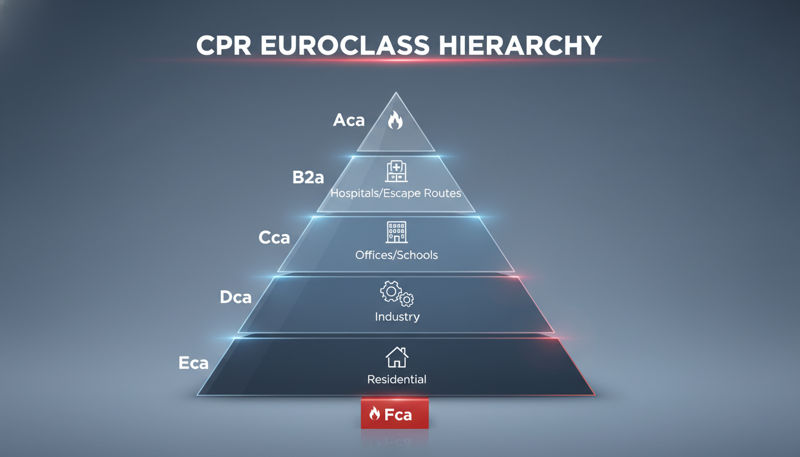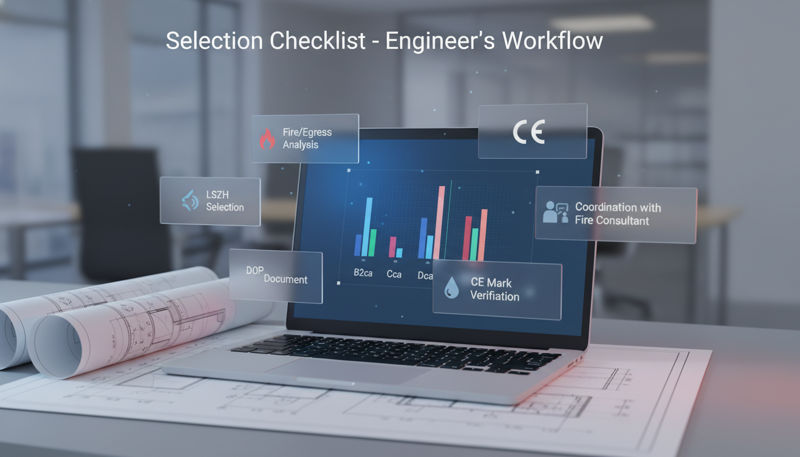Cable & Wire | High quality and excellent service at reasonable prices.
info@zion-communication.com
Author: Michael Publish Time: 23-10-2025 Origin: Site
CPR (EN 50575) rates power/communication/building cables for reaction-to-fire.
Euroclass ladder: Aca (best, rare for cables) → B2ca → Cca → Dca → Eca → Fca.
Suffixes describe by-products: s (smoke: s1/s2/s3), d (flaming droplets: d0/d1/d2), a (acidity/corrosivity: a1/a2/a3).
Proof of compliance = CE mark + DoP (Declaration of Performance).

Note: Always confirm compliance with local building codes and project specifications. Insurers or local authorities may enforce stricter requirements.
Building Zone / Scenario | Typical Risk & Occupancy | Recommended Euroclass | Common Suffix Targets |
Escape routes / Stairwells | Highest life-safety risk; visibility critical for evacuation. | B2ca | s1a/s1b, d0, a1 |
Hospitals / Airports / Arenas | High occupancy; presence of vulnerable users. | B2ca (or high-spec Cca) | s1, d0, a1 |
Schools / Universities | Medium-high occupancy. | Cca | s1, d1, a1 |
Offices / Hotels / Malls | Medium occupancy; mixed fire load. | Cca | s1, d1, a1 |
Residential (Corridors) | Medium occupancy; common areas. | Cca / Dca (per local code) | s1–s2, d1, a1 |
Industrial / Warehouses | Variable fuel load; non-public areas. | Dca | s2, d1, a2 |
Temporary / Utility Spaces | Short term; low population density. | Eca (project dependent) | — |
Identify fire/egress criticality of each cable route (escape path? public assembly?).
Set baseline Euroclass from the matrix (B2ca/Cca/Dca/Eca) and tighten suffixes for smoke/droplet/acidity as needed.
Confirm material system: Prefer LSZH for life-safety routes; assess shielding and jacketing (UV, oil, rodent, low-temp) per environment.
Documentation: Obtain CE mark + DoP number, verify test report references (EN 50399, EN 61034, EN 60754).
Coordination: Align with local building code, fire consultant, and insurer; specify no downgrades by substitution without written approval.

B2ca s1 d0 a1: Premium LSZH ranges for escape routes / high-risk public areas.
Cca s1 d1 a1: General commercial, schools, hotels, malls, offices.
Dca s2 d1 a2: Industrial/utility areas not on escape paths.
Eca: Basic residential and non-critical runs where permitted.
Need exact SKUs, cores, or shielding options (U/UTP, F/UTP, S/FTP; fiber OM3/OM4/OS2)? We can map your BOQ to the closest Zion models at the required Euroclass.
Escape routes (stairs, protected corridors): “Cables shall be B2ca s1 d0 a1 minimum, LSZH, with DoP and CE label on drum and pack.”
Hospitals & care facilities: “Primary services (fire alarm, PA/VA, BMS backbones) B2ca s1 d0 a1; secondary services Cca s1 d1 a1.”
Schools / offices / hotels: “Backbone and risers Cca s1 d1 a1; tenant floor cabling Cca (project dependent).”
Residential towers: “Risers & common corridors Cca s1 d1 a1; in-unit wiring Dca/Eca per local code.”
Industrial (non-egress): “Process/utility cabling Dca s2 d1 a2 unless otherwise specified.”
CE label with manufacturer, DoP number, Euroclass code.
DoP citing EN 50575 and the exact B2ca/Cca/Dca/Eca and s/d/a ratings.
Notified body test references (e.g., EN 50399 heat release/flame spread; EN 61034 smoke; EN 60754 acidity).
Factory QA (AVCP) evidence and traceable batch labels on reels/cartons.
Design for the route, not just the room. If any segment passes an escape path, rate the whole run for that path.
Mixing classes is risky. A single Dca segment in an egress path can compromise evacuation safety.
Insurer uplift. Many projects “up-class” (e.g., Cca→B2ca) for risk management.
Future fit. Standardize on Cca s1 d1 a1 or better across commercial campuses to simplify O&M and stock.
Q1: Is B2ca always required in public buildings?
Not always. Some jurisdictions accept Cca outside escape routes. Check the local fire code and the AHJ/insurer requirements.
Q2: What do s/d/a mean in practice?
Less smoke (s1), no flaming droplets (d0), and low acidity (a1) help maintain visibility, reduce secondary fires, and limit corrosive damage during evacuation.
Q3: Are LSZH cables automatically Cca or B2ca?
No. LSZH helps, but only independent testing under EN 50575 determines the Euroclass.
Contact us for more information

michael@zion-communication.com
+86 13757188184
